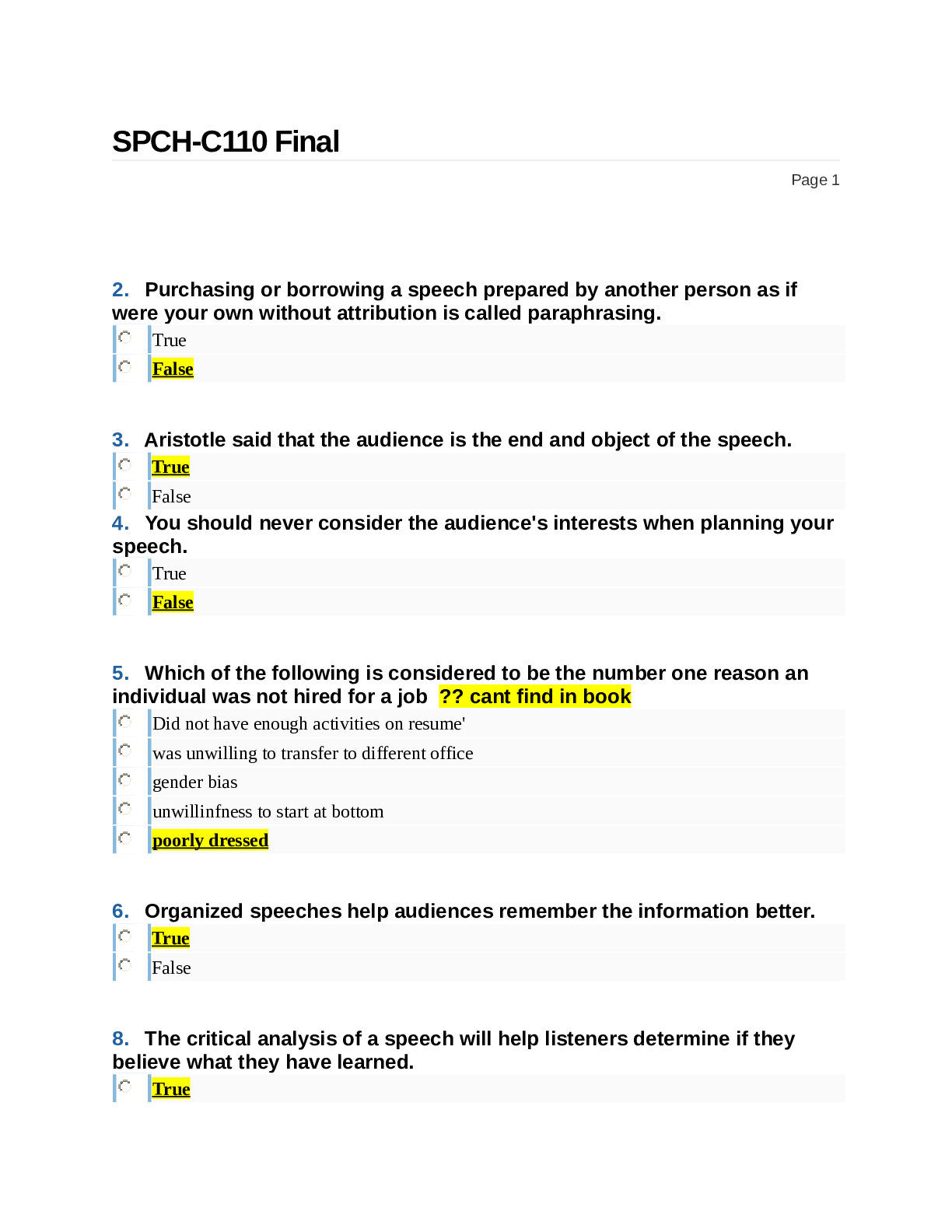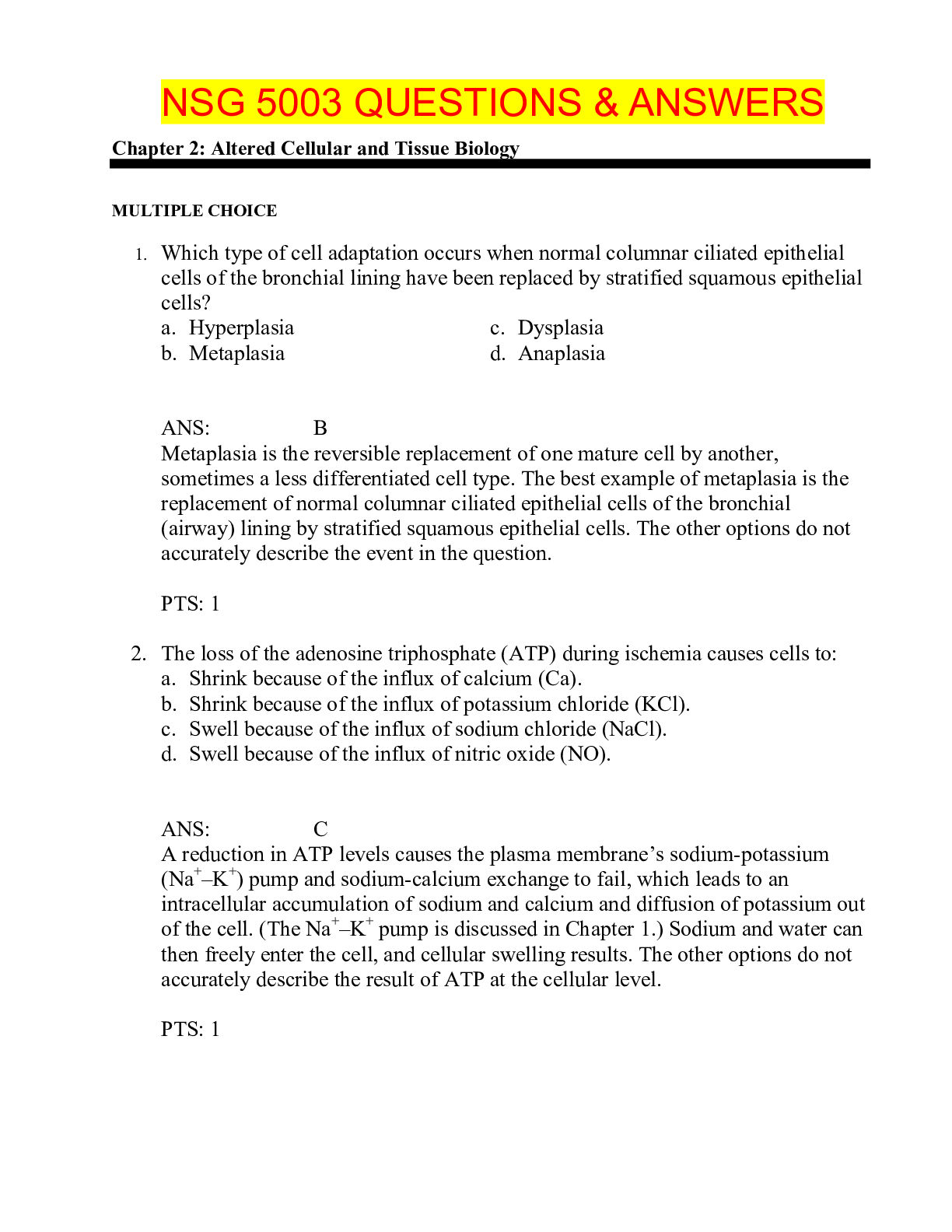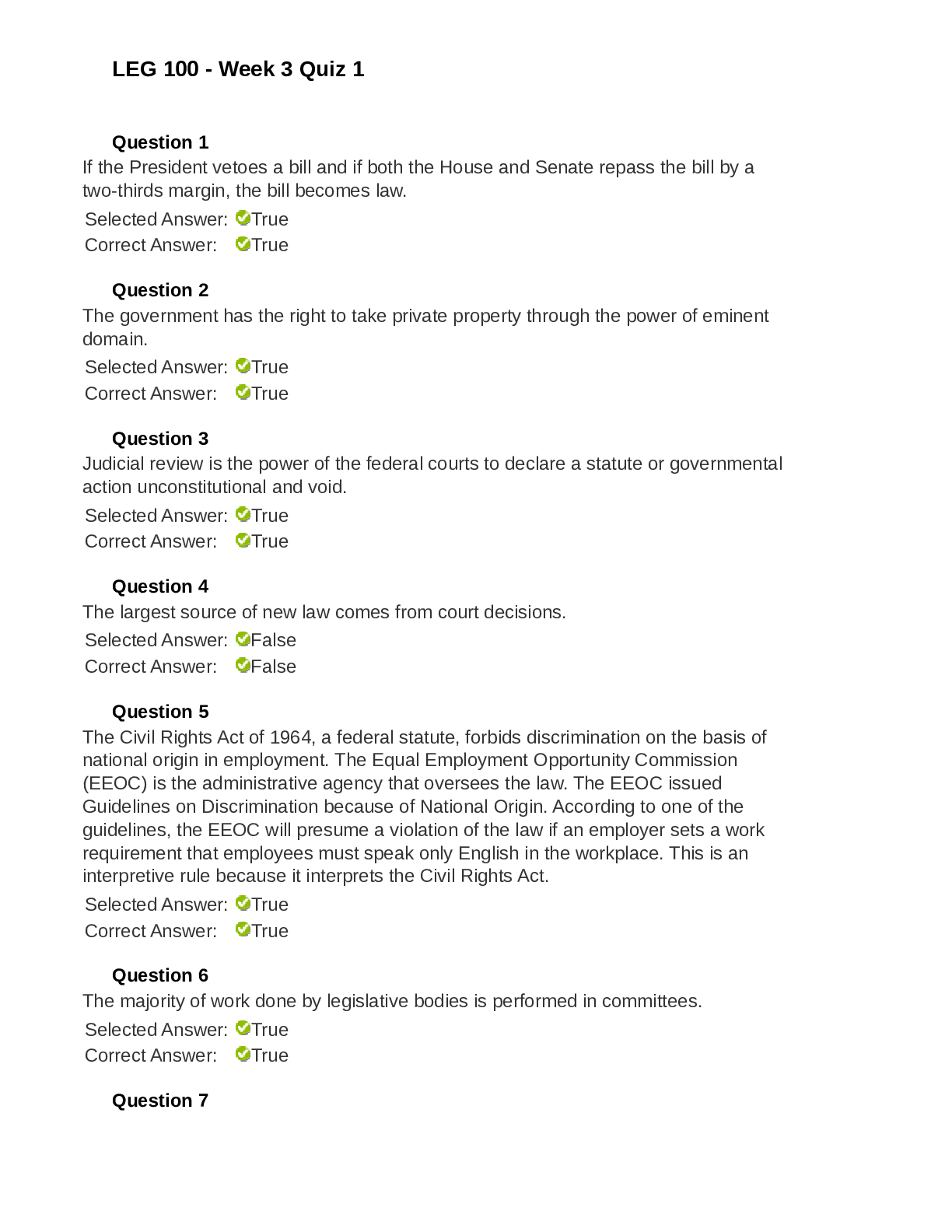SPEECH 101 SPEECH FINAL QUESTIONS & ANSWERS,100% CORRECT
Document Content and Description Below
SPEECH 101 SPEECH FINAL QUESTIONS & ANSWERS SPCH-C1 0 Final Page 1 2. Purchasing or borrowing a speech prepared by another person as if were your own without attribution is called paraph... rasing. True False 3. Aristotle said that the audience is the end and object of the speech. 4. You should never consider the audience's interests when planning your speech. 5. Which of the following is considered to be the number one reason an individual was not hired for a job ?? cant find in book 6. Organized speeches help audiences remember the information better. 8. The critical analysis of a speech will help listeners determine if they believe what they have learned. 10. Creating listener relevance links is a way to suggest how and why they ideas you offer are of interest to yours listeners. A subject is a more specific aspect of a topic. 12. Brainstorming involves evaluating topics as you list them. True False 13. If your audience believes that you are concerned with their interests, you will establish trustworthiness with them. True False 14. By comparing new ideas with familiar ones, speakers can help their audience understand any unknown speech material. True False 15. A speaker can appear more knowledgeable by using complex words that are unfamiliar to his/her audience. True False 16. The bibliographic information you collect from your sources will be the same regardless of the type of source you are using. False 17. Wikipedia would be considered a far more reliable source than a scholarly journal. True False 18. Conducting an experiment to test a hypothesis you have is an example of primary research. 19. A speech about the sequential steps involved in assembling a personal computer would likely be organized using the time order pattern. Thesis statements should always state the main points of your speech. 21. The number of main points should be limited to help audience members keep track of ideas. The only two methods for organizing a source list are alphabetically chronologically. 23. Telling a joke during your introduction has no risk associated with it. False 24. Depending on the type of speech, a source list may not be necessary. True False 25. A word chart is used to preview, review, or highlight important ideas covered in a speech. True False 26. Handouts are best used when handed out in the middle of your speech. True False 28. Visual aids do not help the audience to remember the information. True False 29. Casual swearing will not be frowned upon by the audience, but rather seen as an attempt to create a more realistic approach. True False 30. Using a power point requires that the speaker reads every word on the screen to the audience. 31. We are not born knowing a language; we must learn it. 32. Speakers should avoid using "we" language in their speeches. 33. Facial expressions can supplement and reflect the thoughts of the speaker. True False 34. Pronunciation is the inflection, tone, and speech habits typical to the natives of a country or region. True False 35. Gestures refer to the eye and mouth movement of the speaker. 36. You should consider your topic and purpose when deciding how to dress for your speech. Narration speeches can only be presented in the first person voice. 39. When delivering an exposition of historical events and forces, a speaker has a special obligation to seek out narratives that can enliven the speech. 40. Speaker's whose audience is already familiar with a topic will have an easy time adapting the material. Cant find in book! 43. In persuasive speaking, main points are the vital information that the audience needs to know. 44. If a neutral audience is uninformed about your topic, you need to provide basic information before you try to persuade your audience. 45. According to Maslow, a higher level need can be met before a lower level need, if that need is strong enough. True False 46. It is not ethical to evoke negative emotions during a persuasive speech. True False 48. A good persuasive speaker can effectively argue both sides of an issue. 49. During a speech of introduction, you should hype the credentials of the person being introduced in order to make them feel special. False 50. An example of a commemorative address would be a speech given on the anniversary of D-Day. True False 51. One of the roles of the master/mistress of ceremonies is to set the mood of the program. A speech of introduction recognizes an award winner. 53. Anthony believes his speech about the budgeting process for student fees demonstrates because the topic is pertinent to the personal life space of the students on campus. 54. Stating, "We all worry, in some way, about our future. If we do not address our planet's environmental status, then we might not have a future," is an example of: 56. Is a speaker informed his/her own audience, "The average distance from the Earth to the Sun is 93 million miles. If you left Earth, traveling by car, you would reach the sun in 152 years," what type of comprehension technique is in use? 58. Demonstrating how information is useful now, or will be in the future, is known as: 60. The confidence that an audience places in the truthfulness of what a speaker says is known as: 61. Communicating respect for, and acceptance of, the audience is a matter of: Speaking appropriately 62. means using the language that adapts to the needs, interests, knowledge, and attitudes of the listeners and avoiding language that alienates the audience. 63. is a word's direct, explicit meaning given by its language community: 65. If a speaker attempts to evoke the audience's sense (touch, taste, sight, hearing) then he/she is relying on: 67. If an audience is having difficulty understanding the intended meaning of a word, it can refer to the word's , or its relationship to other words in the sentence. 68. What is problematic with a speaker begging the audience, "Guys, we can make a difference in the fight against violence if we just organize our resources"? Having eye contact means: An extemporaneous speech is: One way to emphasize an idea through bodily action is through; 77. If a speaker wants to explain or describe facts, truths, and principles in a way that stimulates interest, facilitates understanding and increases understanding then he/she would want to use a(n) speech. 80. The most common framework for an informative speech is a process of that shows how something is done, or how something works. 81. When a speaker tries to think about something from a variety of perspectives, it is known as: 83. A speaker uses to produce new or original ideas and insight that will help build a speech. 85. The fallacy of reasoning suggests that there are only two alternatives in a situation when in fact there are others. 88. If your argument included three diseases caused by smoking, you would be arguing from: 90. The organizational pattern that persuades by both disproving the opposing position and bolstering one's own is the organization pattern. 91. When the support statements you are using are examples of the claim you are making, you are arguing from: 92. A statement designed to convince your audience that something is or is not true, exists, or happens is a proposition of: The expenditures incurred from a particular action are called: 96. The persuasive organizational pattern is particularly useful when the audience may be unaware of the problem or how they personally can work toward a solution. Incentives action, while costs action. 98. In a speech designed to encourage volunteering at a soup kitchen, a speaker offers the audience a one dollar coupon to a restaurant of choice in exchange for a day-long volunteer effort. Why might this fail? 99. Speakers who show their concern for the audience by acknowledging its feedback are considered: 101. In a welcome speech you are expected to: 102. When presenting someone with an award or gift, as in a speech of recognition, the speaker should: 103. A speech that begins a conference or a convention is called a: 104. The is an individual designated to set the mood of the program, introduce participants and keep the program moving. 105. A speech that recognizes a graduation is called a: 107. A speech of introduction should: 3. According to the textbook, one of the most sought after skills in hires is computational skills. True False 4. It helps to be a little nervous to do your best True False 6. An audience is unlikely to detect the level of nervousness of a speaker. ? cant find in book True False 7. Asking yourself questions during a speech can distract you from learning its key aspects. True False 10. The speaking situation only includes the physical setting of the speech and the audience. True False 11. A specific goal states the overall intent of the speech. True False 12. Age, gender, and ethnicity are examples of subject-related audience data. True False 13. Audience members often assume that they have nothing in common with the speaker or others in the audience. True False 16. Failure to cite sources is unethical. True False 17. One means of conducting research for a speech is to view an artifact at a local museum that is relevant to your speech. True False 19. Narrative order organizes the main points of your speech based upon aspects of a story or series of stories. True False 20. "To illustrate" or "for example" are examples of signposts. True False 22. In addition to the source in the outline, sources should also be cited in the speech body. True False 24. A speech's introductory remarks set the overall tone for the speech. True False 25. According to the textbook, using yourself as a visual aid is not an option. True False 26. When using visual aids, it is a good idea to indicate on your notes when you should introduce and use your visual aid. True False 27. It is important that everyone in the audience can see your visual aid. True False 30. Antithesis involves combining contrasting ideas in the same sentence. True False 35. Monotone refers to a voice in which pitch, volume, and rate significantly differ from word to idea or sentence. True False 36. Articulation is the loudness or softness of the syllables of each word in the speech. True False 39. Creativity and Organization are key elements for the impromptu speech. True False 41. A proposition of policy is a statement designed to convince your audience that they should take a specific course of action. True False 46. When the goal is to motivate audience members to act, speakers must provide the audience with incentives that outweigh the costs of action. True False 47. Audience members are more likely to listen if they feel an emotional attachment to, or realize a personal consequence in, the information in a speech. True False 49. During a speech of nomination, you should link the nominee's credentials to the position. True False 50. It is appropriate in a commencement address to make a political statement and ignore the graduating class. True False 51. An acceptance speech is a response to a speech of recognition. True False 52. A eulogy is a tribute speech given as a retirement, birthday, or anniversary. False 56.One way to display personableness is to: Arrive "fashionably late" for a speech Smile and establish eye contact Be critical of other speeches Over-prepare for the speech 60.Stating "we need to be concerned about tuition increases" rather than "students need to be concerned about tuition increases" demonstrates the use of to link the speaker to members of the audience: Relevance Timeliness Personal impact statements Personal pronouns 65."Round and round the rugged rock the ragged rascal ran" is an example of a(n) because of the repetition of consonant sounds at the beginning of words that are near one another. Alliteration Assonance Onomatopoeia repetition 67. is the feeling or evaluation associated with a word. Denotation Demarcation Connotation Context 69. When a person distorts the sound in a word, the problem is called: A grammatical mistake An articulation error An error in pronunciation Nonfluency A phonetic error 70. A person is said to have a(n) when they have speech habits typical of a certain geographic area: Accent Dialect Timbre None of these 71. Common articulation problems include: Emission and reduction Slurring sounds and leaving off endings of words Transposition, repetition and execution Stuttering and lisping 74. Which of the following is NOT an aspect of nonverbal communication? Facial expressions Gestures Voice articulation All of the above 75. Highness or lowness of voice describes the term: Pitch Volume Rate Quality 76. A speech that is prepared and practiced, but the exact wording is to be determined at the time of utterance is one that is: Impromptu Memorized Scripted Extemporaneous 78.The method is used to create an accurate vivid picture of the speech's subject, while the method explains something by identifying its meaning. Description; definition Definition; description Demonstration; narration Narration; demonstration 80. Which of these is true about creativity as it relates to the speech making process? Creativity begins with lots of research Creativity takes time Creativity occurs when you think about things from a variety of perspectives All of these are true 81. If a speaker delivers an in-depth research presentation, it is called an speech. Extemporaneous Explicit Explanatory Expository 82. Informing the audience of how public universities are similar to and different from private universities is an example of a(n) informat ive speech Description/definition Narration Compare/contrast Demonstration 83.A speech on the development of the rollercoaster over time is known as an exposition of: Historical events and forces A theory, principle, or law A creative work Political, economic, social, religious or ethical issues 86.Evidence that includes facts, opinion, experiences, and observations is: Claim Warrant Support Proposition 90.The type of speech whose goal is to influence the attitudes, beliefs, values, or behavior of audience members: Persuasive Informative Special occasion Commencement 96.The speech to not only affects the audience's beliefs and attitudes, but also motivates the audience to act. Activate Amputate Actuate Ameliorate 99.The organizational pattern responsible for encouraging action in the audience is called pattern. Logical reasons Motivated reasons Logical sequence Motivated sequence 101. A speech that acknowledges someone and usually presents an award, a prize, or a gift to the individual or a representative of a group is called a: Speech of welcome Speech of introduction Speech of recognition Speech of acceptance 102. A speech that expressed pleasure for the presence of a person or an organization if called a: Speech of welcome Speech of recognition Speech of acceptance 103. A eulogy is a type of speech Tribute Recognition Welcome Keynote [Show More]
Last updated: 1 year ago
Preview 1 out of 40 pages
Instant download

Buy this document to get the full access instantly
Instant Download Access after purchase
Add to cartInstant download
Reviews( 0 )
Document information
Connected school, study & course
About the document
Uploaded On
Jun 10, 2021
Number of pages
40
Written in
Additional information
This document has been written for:
Uploaded
Jun 10, 2021
Downloads
0
Views
79





















